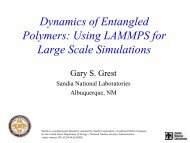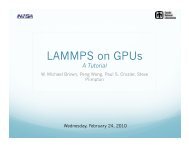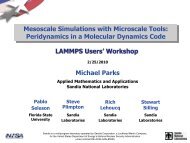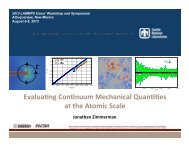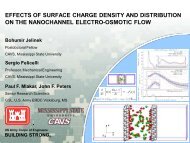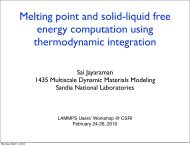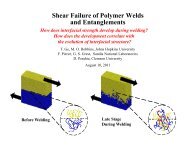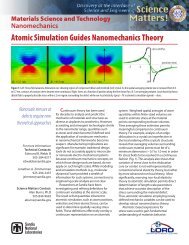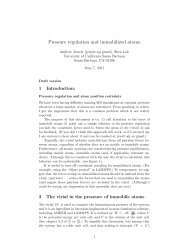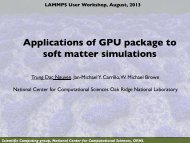GPU Acceleration in LAMMPS
GPU Acceleration in LAMMPS
GPU Acceleration in LAMMPS
- No tags were found...
You also want an ePaper? Increase the reach of your titles
YUMPU automatically turns print PDFs into web optimized ePapers that Google loves.
<strong>GPU</strong> <strong>Acceleration</strong> <strong>in</strong> <strong>LAMMPS</strong> W. Michael Brown Na1onal Center for Computa1onal Sciences Oak Ridge Na1onal Labs August 10, 2011
WHY DO WE CARE ABOUT <strong>GPU</strong>S?
Clock Rates are not Increas<strong>in</strong>g Power = Capacitance * Frequency * Voltage 2 + Leakage • Tradi1onally, as Frequency <strong>in</strong>creased, Voltage decreased, keep<strong>in</strong>g the total power <strong>in</strong> a reasonable range • But we have run <strong>in</strong>to a wall on voltage • As the voltage gets smaller, the difference between a “one” and “zero” gets smaller. Lower voltages mean more errors. • Capacitance <strong>in</strong>creases with the complexity of the chip • Total power dissipa1on is limited by cool<strong>in</strong>g
Power to move data Energy_to_move_data = bitrate * length 2 / cross_sec1on_area_of_wire • The energy consumed <strong>in</strong>creases propor1onally to the bit-‐rate, so as we move to ultra-‐high-‐bandwidth l<strong>in</strong>ks, the power requirements will become an <strong>in</strong>creas<strong>in</strong>g concern. • The energy consump1on is highly distance-‐dependent (the square of the length term), so bandwidth is likely to become <strong>in</strong>creas<strong>in</strong>gly localized as power becomes a more difficult problem. • Improvements <strong>in</strong> chip lithography (mak<strong>in</strong>g smaller wires) will not improve the energy efficiency or data carry<strong>in</strong>g capacity of electrical wires. D. A. B. Miller and H. M. Ozaktas, “Limit to the Bit-‐Rate Capacity of Electrical Interconnects from the Aspect RaCo of the System Architecture,” Journal of Parallel and Distributed CompuCng, vol. 41, pp. 42-‐52 (1997) arCcle number PC961285.
350 300 250 200 150 100 50 0 CPU Data Transfer Data Cast Force Interp (27.8x Speedup) Field Solve Charge Spread (13.7x Speedup) Other Output Comm Neigh (8.4x Speedup) Bond Pair (50x Speedup) 8.6x <strong>GPU</strong> <strong>GPU</strong> Accelera1on Currently Available for: § Neighbor list builds § Par1cle-‐Par1cle Par1cle-‐Mesh § Non-‐bonded short-‐range poten1als <strong>GPU</strong> ACCELERATION IN <strong>LAMMPS</strong>
Accelerated Non-‐bonded Short-‐Range Potentials • S<strong>in</strong>gle, mixed, and double precision support for: • lj/cut • lj96/cut • lj/expand • lj/cut/coul/cut • lj/cut/coul/long • lj/charmm/coul/long • lj/class2 • lj/class2/coul/long • morse • cg/cmm • cg/cmm/coul/long • coul/long • gayberne • resquared
Neighbor List Builds • Accelera1on is Op1onal • Can’t use neighbor list builds on the accelerator with tricl<strong>in</strong>ic box or with “hybrid” models that use mul1ple accelerated pair styles • Don’t use neighbor list builds on the accelerator with hybrid pair styles or when a compute or fix requires a neighbor list • Neighbor list builds use a sort to order atoms • This results <strong>in</strong> addi1onal overhead, but gives determ<strong>in</strong>is1c results • Speedup for neighbor-‐list builds with accelera1on is currently highly dependent on the number of par1cles
Particle-‐Particle Particle-‐Mesh • Accelera1on is op1onal • Can be performed <strong>in</strong> s<strong>in</strong>gle or double precision • Charge assignment and force <strong>in</strong>terpola1on rou1nes are accelerated, Poisson solve is not • Accelerated rou1nes use the same FFT library as the standard rou1nes • Unlikely to see any significant improvement from accelera1on for typical system sizes or parallel runs on current hardware
USE <strong>GPU</strong>S <strong>GPU</strong>S “All rou1nes must be ported to the <strong>GPU</strong> <strong>in</strong> order to compete with mul1-‐core CPUs due to Amdahl's law” “Data transfer is the bolleneck when us<strong>in</strong>g <strong>GPU</strong> accelera1on” “Double precision calcula1ons are much slower than s<strong>in</strong>gle precision on current hardware” OWen true, but not always… UNDERSTANDING <strong>GPU</strong> ACCELERATION (IN <strong>LAMMPS</strong>)
“All rout<strong>in</strong>es must be ported to the <strong>GPU</strong> <strong>in</strong> order to compete with multi-‐core CPUs due to Amdahl's law” • Codes can be compe11ve if they parallelize non-accelerated rou1nes on the CPU • Example: Rhodops<strong>in</strong> Benchmark on a box with 12 CPU cores and 1 <strong>GPU</strong> • Here, only the non-‐bonded “pair” force calcula1on is accelerated for an example • Speedup on 1 CPU core with a <strong>GPU</strong> is only 2.6x with this approach • Speedup vs 12 CPU cores is s1ll > 2x because we use all 12 cores <strong>in</strong> addi1on to the <strong>GPU</strong> 250 200 150 100 50 0 Other Output Comm Neigh Kspce Bond Pair CPU <strong>GPU</strong>+CPU CPU <strong>GPU</strong>+CPU CPU <strong>GPU</strong>+CPU CPU <strong>GPU</strong>+CPU CPU <strong>GPU</strong>+CPU 1 CPU Core 2 CPU Cores 4 CPU Cores 8 CPU Cores 12 CPU Cores
M<strong>in</strong>imiz<strong>in</strong>g the Code Burden • Focus por1ng efforts on the rou1nes that dom<strong>in</strong>ate the computa1onal 1me and have high poten1al for speedup with accelerators • Use concurrent CPU/<strong>GPU</strong> calcula1ons where possible and overlap host-‐accelerator data transfer with computa1on
Host-‐Device Load Balanc<strong>in</strong>g (-‐ PPPM <strong>Acceleration</strong>) Not to scale <strong>GPU</strong> Nbor Core 1 Nbor Core 2 Nbor Core 3 Nbor Core 4 Data Transfer In Pair Core 1 CPU Core 1 Pair CPU Core 2 CPU Core 3 CPU Core 4 Can run force models not ported to <strong>GPU</strong> concurrently with models ported to <strong>GPU</strong> (e.g. Neighbor<strong>in</strong>g is not performed every solvent on <strong>GPU</strong>) 1mestep. 1 <strong>in</strong> 10-‐20. Adjusts split of non-‐bonded force calcula1on automa1cally or by specify<strong>in</strong>g a fixed split Pair Pair Pair Pair Core 2 Bond Bond Bond Bond Pair Core 3 Long Range ElectrostaBcs Long Range ElectrostaBcs Long Range ElectrostaBcs Long Range ElectrostaBcs Pair Core 4 Data Transfer Out Other Other Other Other
Host-‐Device Load Balanc<strong>in</strong>g (+PPPM <strong>Acceleration</strong>) <strong>GPU</strong> CPU Core 1 CPU Core 2 CPU Core 3 CPU Core 4 Nbor Core 1 Nbor Core 2 Nbor Core 3 Nbor Core 4 Can run mul1ple kernels at the same 1me on some accelerators Data Transfer In Pair Pair Pair Pair Pair Core 1 Pair Core 2 Pair Core 3 Pair Core 4 Bond Bond Bond Bond Charge Spread Core 1 Charge Spread Core 2 Charge Spread Core 3 Charge Spread Core 4 Poisson Solve Poisson Solve Poisson Solve Poisson Solve Force Interp Core 1 Force Interp Core 2 Force Interp Core 3 Force Interp Core 4 Data Transfer Out Other Other Other Other
M<strong>in</strong>imiz<strong>in</strong>g the Code Burden • Advantages • Allow a legacy code to take advantage of accelerators without rewri1ng the en1re th<strong>in</strong>g • In some cases, there is no advantage to por1ng • Mul1-‐Core CPUs can be compe11ve with <strong>GPU</strong> accelerators for some rou1nes (latency-‐bound, thread divergence, etc.), especially at lower par1cle counts • If concurrent CPU/<strong>GPU</strong> calcula1ons are used effec1vely, there can be no advantage to por1ng certa<strong>in</strong> rou1nes • For some simula1ons, the upper bound for performance improvements due to por1ng addi1onal rou1nes and remov<strong>in</strong>g data transfer is < 5%.
M<strong>in</strong>imiz<strong>in</strong>g the Code Burden • Disadvantages • For some simula1ons, the upper bound for performance improvements due to por1ng addi1onal rou1nes and remov<strong>in</strong>g data transfer is as high as 50% (for up to 1 million par1cles on a s<strong>in</strong>gle <strong>GPU</strong> with current hardware). • Increas<strong>in</strong>g the number of MPI processes can impact <strong>in</strong>terprocess communica1on performance • Mul1ple MPI processes shar<strong>in</strong>g a <strong>GPU</strong> currently results <strong>in</strong> the execu1on of more kernels, each with a smaller amount of work • Paralleliza1on of the CPU rou1nes with OpenMP would likely be a significant effort for efficient simula1ons <strong>in</strong> <strong>LAMMPS</strong>. USER-‐CUDA package is now available <strong>in</strong> <strong>LAMMPS</strong> as an alternaCve library for acceleraCon. In some cases, the enCre simulaCon can be run on the <strong>GPU</strong>.
“Data transfer is the bottleneck when us<strong>in</strong>g <strong>GPU</strong> acceleration” • If neighbor list builds are performed on the <strong>GPU</strong>, data transfer can be a small frac1on of the total simula1on 1me • For this reason, accelerated neighbor list builds can be important despite the rela1vely poor performance on the <strong>GPU</strong> • For the rhodops<strong>in</strong> benchmark, data transfer is less than 6% of the <strong>GPU</strong> calcula1on 1mes • Will be a smaller percentage of the total simula1on 1me because the calcula1on of bonded forces, 1me <strong>in</strong>tegra1on with a thermostat/barostat, SHAKE, and the Poisson solve must be calculated somewhere and we need to do MPI comm • In some cases, can benefit from overlapp<strong>in</strong>g data transfer with computa1on 100% 90% 80% 70% 60% 50% 40% 30% 20% 10% 0% Force Interpola1on Short Range Force Data Pack Charge Assignment Neighbor Build Data Transfer 1 2 4 8 16 32 <strong>GPU</strong>s/CPU Cores
“Double precision calculations are much slower than s<strong>in</strong>gle precision on current hardware” • Less double precision ALUs on current hardware • Full double precision is usually significantly slower for most kernels • Mixed precision can give very similar performance • Double precision performance can be more similar for latency-‐bound kernels (PPPM). 1000.00 Wall Time 32 16 8 4 2 1 0.5 4-‐SP 4-‐DP 5-‐SP 5-‐DP 6-‐SP 6-‐DP 5-‐CPU 1 2 4 8 16 32 <strong>GPU</strong>s/CPU Cores Loop Time (s) 100.00 10.00 1.00 CPU (12 PPN) S<strong>in</strong>gle (6 PPN) Mixed (6 PPN) Double (6 PPN) Nodes (3 <strong>GPU</strong>s + 12 Cores Per Node) 1 2 4 8 16 32 CPU (12 PPN) 297.80 151.53 76.74 38.71 20.44 10.83 S<strong>in</strong>gle (6 PPN) 37.44 19.16 10.66 6.31 4.02 3.08 Mixed (6 PPN) 45.13 23.07 12.65 7.25 4.46 3.36 Double (6 PPN) 94.04 48.33 25.97 14.40 8.24 5.30
CUDA OpenCL Libraries Direc1ves … ACCELERATOR PROGRAMMING MODEL/API
Geryon Library • Allows same code to compile with CUDA Run1me, CUDA Driver, and OpenCL APIs • Allows portability to AMD accelerators, CPUs, and any future chips with OpenCL support • Currently supports all kernels except for neighbor list builds • This will probably be added soon Time / Total CUDA Time 1.4 1.2 1 0.8 0.6 0.4 0.2 0 CUDA Short Range Force Interpola1on Charge Assignment Par1cle Map Data Transfer OpenCL • hlp://users.nccs.gov/~wb8/geryon/<strong>in</strong>dex.htm
Can’t give a s<strong>in</strong>gle number for performance improvements to expect from accelera1on Depends on the model, the system, and the simula1on parameters Depends on the hardware, CPUs, the type of accelerator, and the <strong>in</strong>terconnect bandwidths Even on the same <strong>GPU</strong>, results can differ by up to 30% depend<strong>in</strong>g on the ECC configura1on Follow<strong>in</strong>g are results from standard <strong>LAMMPS</strong> benchmarks and some science applica1ons on the Keeneland <strong>GPU</strong> Cluster 2 Intel Westmere 2.8 GHz Hex Core CPUs 3 Tesla M2070 <strong>GPU</strong>s, ECC On, QDR Inf<strong>in</strong>iband, 120 Nodes Input files available at: hlp://users.nccs.gov/~wb8/gpu/keeneland.htm BENCHMARKS
Atomic Lennard-‐Jones Fluid (256k atoms) • Good lower bound to <strong>LAMMPS</strong> performance improvements • Low arithme1c <strong>in</strong>tensity, small neighbor lists 1000.00 Loop Time (s) 100.00 10.00 CPU (12 PPN) CPU+<strong>GPU</strong> (3 PPN) CPU+<strong>GPU</strong> (6 PPN) CPU+<strong>GPU</strong> (12 PPN) Speedup Nodes (3 <strong>GPU</strong>s + 12 Cores Per Node) 1.00 1 2 4 8 16 32 CPU (12 PPN) 123.03 60.93 31.80 16.59 9.62 5.61 CPU+<strong>GPU</strong> (3 PPN) 43.42 21.53 12.09 9.91 7.34 5.84 CPU+<strong>GPU</strong> (6 PPN) 31.69 15.79 9.35 6.57 4.94 4.18 CPU+<strong>GPU</strong> (12 PPN) 27.54 15.25 10.48 7.94 6.68 5.85 Speedup 4.47 4.00 3.40 2.53 1.95 1.34
Atomic Lennard-‐Jones Fluid (256k atoms) • For problems requir<strong>in</strong>g a larger cutoff, results are much beler • Here, the cutoff is <strong>in</strong>creased from 2.5 sigma to 5.0 sigma Loop Time (s) 1000 100 10 CPU (12 PPN) CPU+<strong>GPU</strong> (3 PPN) CPU+<strong>GPU</strong> (6 PPN) CPU+<strong>GPU</strong> (12 PPN) Speedup Nodes (3 <strong>GPU</strong>s + 12 Cores Per Node) 1 1 2 4 8 16 32 CPU (12 PPN) 297.796 151.528 76.7366 38.7134 20.4366 10.83 CPU+<strong>GPU</strong> (3 PPN) 40.68 20.56 11.29 6.86 4.57 3.49 CPU+<strong>GPU</strong> (6 PPN) 37.44 19.16 10.66 6.31 4.02 3.08 CPU+<strong>GPU</strong> (12 PPN) 37.67 19.79 10.96 6.62 4.93 4.15 Speedup 7.95 7.91 7.20 6.14 5.09 3.52
Ellipsoidal Particles (256k particles) • Good upper bound to <strong>LAMMPS</strong> performance improvements with accelera1on • High arithme1c <strong>in</strong>tensity, transcendentals, pairwise force calcula1on dom<strong>in</strong>ates the simula1on 1me 10000.0 1000.0 CPU (12 PPN) CPU+<strong>GPU</strong> (3 PPN) CPU+<strong>GPU</strong> (6 PPN) CPU+<strong>GPU</strong> (12 PPN) Speedup 10000.00 1000.00 CPU (12 PPN) CPU+<strong>GPU</strong> (3 PPN) CPU+<strong>GPU</strong> (6 PPN) CPU+<strong>GPU</strong> (12 PPN) Speedup Loop Time (s) 100.0 10.0 Loop Time (s) 100.00 10.00 Nodes (3 <strong>GPU</strong>s + 12 Cores Per Node) 1.0 1 2 4 8 16 32 CPU (12 PPN) 2811.9 1418.3 704.33 356.73 186.92 91.32 CPU+<strong>GPU</strong> (3 PPN) 237.29 118.76 60.26 30.12 15.28 8.79 CPU+<strong>GPU</strong> (6 PPN) 207.67 104.63 52.32 25.31 14.36 9.35 CPU+<strong>GPU</strong> (12 PPN) 194.40 96.62 48.88 27.51 17.57 11.37 Speedup 14.46 14.68 14.41 14.09 13.01 10.40 Gay-‐Berne 1.00 CPU (12 PPN) CPU+<strong>GPU</strong> (3 PPN) CPU+<strong>GPU</strong> (6 PPN) Nodes (3 <strong>GPU</strong>s + 12 Cores Per Node) 1 2 4 8 16 32 4125.082057.41 1025.87 533.41 264.88 153.68 395.40 199.17 99.88 49.92 25.07 13.46 389.47 195.69 97.93 48.32 25.49 14.39 CPU+<strong>GPU</strong> (12 PPN) 390.68 194.11 96.60 50.80 28.51 16.27 Speedup 10.59 10.60 10.62 11.04 10.57 11.42 RE-‐Squared
Aspherical Coarse-‐Gra<strong>in</strong><strong>in</strong>g • Computa1onal cost of a s<strong>in</strong>gle ellipsoid-‐ellipsoid <strong>in</strong>terac1on can be 15x that for Lennard-‐Jones on the CPU • With <strong>GPU</strong> accelera1on, it is more compe11ve • Higher arithme1c <strong>in</strong>tensity, so beler speedup when compared to LJ accelera1on • Beler parallel efficiency relaCve to the CPU • S1ll get performance with fewer threads Morriss-‐Andrews, A., RoTler J., Plotk<strong>in</strong> S. S., JCP 132, 035105, 2010. Mergell, B., Ejtehadi, M.R., Everaers, R., PRE, 68, 021911 (2003) Orsi, M. et al, J. Phys. Chem. B, Vol. 112, No. 3, 2008
Rhodops<strong>in</strong> Prote<strong>in</strong> (32K Atoms; Scaled 256K Atoms) • CHARMM force field with a 10 angstrom cutoff • Requires calcula1on of bonded terms, long range electrosta1cs (PPPM), and SHAKE-‐constra<strong>in</strong>ed 1me <strong>in</strong>tegra1on with a Nose-‐Hoover style thermostat/barostat • Poisson solve <strong>in</strong> PPPM is a larger percentage of the total simula1on 1me and therefore can have a more significant impact on parallel efficiency Wall Time 512 256 128 64 32 16 8 4 32K CPU (12) 32K <strong>GPU</strong> (3) 32K <strong>GPU</strong> (6) 256K CPU (12) 256K <strong>GPU</strong> (3) 256K <strong>GPU</strong> (6) 256K <strong>GPU</strong> (12) 1 2 4 8 16 32 Nodes (3 <strong>GPU</strong>s, 12 Cores per Node)
Bottle-‐Brush Polyelectrolytes Courtesy of Jan-‐Michael Carrillo and Andrey Dobryn<strong>in</strong> University of Connecticut Russano, D., Carrillo, J.Y., Dobryn<strong>in</strong>, A.V. InteracBon between Brush Layers of BoTle-‐Brush Polyelectrolytes, Langmuir, In Press.
Bottle-‐Brush Polyelectrolytes
Bottle-‐Brush 128.00 64.00 Polyelectrolytes Time (s) 32.00 16.00 8.00 4.00 • <strong>GPU</strong> Benchmarks • 500 MD steps were performed with an <strong>in</strong>tegra1on 1mestep of 0.01 τ LJ • Long range electrosta1cs via PPPM (1e-‐4) • Explicit solvent • Include all of the “fixes”, sta1s1cs calcula1ons, and I/O from produc1on runs • (1 configura1on dump and 1 checkpo<strong>in</strong>t dump) Time (s) 2.00 1.00 1 2 4 8 16 cpu_D030_12 81.14 43.48 25.69 14.90 8.57 gpu_D030_06 21.65 13.73 9.01 6.09 4.07 Speedup 3.78 3.17 2.85 2.45 2.10 161194 Par1cles 512.00 256.00 128.00 64.00 32.00 16.00 8.00 4.00 2.00 1.00 1 2 4 8 16 32 cpu_D140_12 286.44 157.09 94.77 48.80 36.29 18.39 gpu_D140_03 71.33 40.08 22.97 16.59 10.33 6.83 gpu_D140_06 60.85 34.55 22.50 13.92 9.23 7.38 gpu_D140_12 58.54 37.25 Speedup 4.89 4.55 4.21 3.50 3.93 2.69 587971 Par1cles
<strong>GPU</strong> ACCELERATION AT ORNL
Titan • Titan, the successor to the Jaguar supercomputer, will use Cray’s accelerated XK6 node design with <strong>GPU</strong>s
Titan System Goals • Designed for science from the ground up • Opera1ng system upgrade of today’s L<strong>in</strong>ux Opera1ng System • Gem<strong>in</strong>i <strong>in</strong>terconnect • 3-‐D Torus • Globally addressable memory • Advanced synchroniza1on features • 10-‐20 PF peak performance • 9x performance of today’s XT5 • Larger memory • 3x larger and 4x faster file system 1000.00 100.00 Time 10.00 <strong>LAMMPS</strong> Prote<strong>in</strong> SimulaBon SeaStar 2+ Gem<strong>in</strong>i 1.00 10 100 1000 Cores Courtesy of Sarah Anderson, Cray Inc.
Gett<strong>in</strong>g Access to Jaguar/Titan • INCITE -‐ Novel Computa1onal Impact on Theory and Experiment Program • Typically awards millions of processor-‐hours per project • Addresses grand challenges <strong>in</strong> science and eng<strong>in</strong>eer<strong>in</strong>g • There is an annual call for INCITE proposals and awards are made on an annual basis • hlp://www.er.doe.gov/ascr/INCITE/<strong>in</strong>dex.html • ALCC – The ASCR Leadership Compu1ng Challenge • Emphasis on high-‐risk, high-‐payoff simula1ons • DOE energy mission areas • advanc<strong>in</strong>g the clean energy agenda • understand<strong>in</strong>g the Earth’s climate, … • open to na1onal labs, academia, <strong>in</strong>dustry • hlp://www.er.doe.gov/ascr/Facili1es/ALCC.html • DD – Director’s Discre1on projects • dedicated to leadership compu1ng prepara1on, INCITE and ALCC scal<strong>in</strong>g, and applica1on performance to maximize scien1fic applica1on efficiency and produc1vity • hlp://www.nccs.gov/user-‐support/access/project-‐request/
Future Work • Improve performance at smaller par1cle counts • Neighbor list build is the problem • Improve long-‐range performance • MPI/Poisson Solve is the problem • Further performance improvements focused on specific science problems • Collabora1ons welcome • Ques1ons?
Details on Methods Used • Brown, W.M., Wang, P. Plimpton, S.J., Tharr<strong>in</strong>gton, A.N. ImplemenBng Molecular Dynamics on Hybrid High Performance Computers – Short Range Forces. Computer Physics CommunicaCons. 2011. 182: p. 898-‐911. • Brown, W.M., Kohlmeyer, A., Plimpton, S.J., Tharr<strong>in</strong>gton, A.N. ImplemenBng Molecular Dynamics on Hybrid High Performance Computers – ParBcle-‐ParBcle ParBcle-‐Mesh. Submi[ed.



